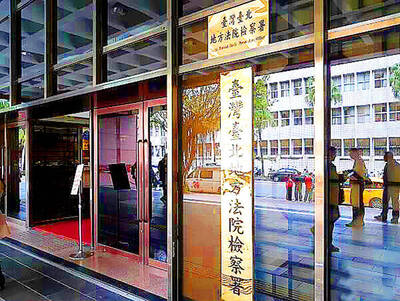Top government officials are currently weighing the possibility of replacing National Security Bureau (NSB) Director General Ting Yu-chou (
While the government has not yet made a final decision on the matter, sources said that leaders are more inclined to keep Ting at his position to assist in restructuring the bureau and to help improve the country's national security system.
An official with the NSB, who spoke on condition of anonymity, said replacing Ting may not be a cure-all and that it would not be fair for Ting to take the full blame for both the unapproved departure to China by Pan Hsi-hsien (
Pan, who retired June 1 at the rank of major general and departed for China three days later, was taken into custody by Chinese security agents in Guangdong Province at the end of last month. It is believed that he is still being held by the Chinese authorities.
Pan's plan to go to China and work there was known by a number of his colleagues, who held a farewell party for him before he left the service, internal investigations by the NSB indicated.
Because subordinates concealed Pan's China trip plan from him, General Ting was most likely the only one at the bureau unaware of the trip, and probably did not know of it until it was first exposed by legislators and later extensively reported in the press.
As chief of the country's top intelligence agency, Ting is supposed to know everything relating to the country's national security, but he apparently failed the public's expectations in this regard.
But the matter is complicated by several factors, such as a personal feud between Ting and Pan, factionalism in the bureau and personal problems with Pan.
According to a recently-released report on the incident by the Control Yuan, Pan was forced to take early retirement because of a drunk driving incident at the beginning of this year.
To Pan and other servicemen, early retirement means lost salary and a scaling down of retirement pension packages.
Pan's monthly salary before retirement was about NT$100,000, but his monthly income could be as high as NT$200,000 if allowances and subsidies were taken into account, intelligence sources said.
Pan's early retirement could have cost him as much as NT$1 million, compared to what he would have received had he retired as scheduled at the end of the year. His forced departure had certainly much to do with Ting, who is known for demanding his staff remain "clean," sources said.
Another dimension to the Pan incident is factionalism in the bureau. Pan was widely known to have been brought into the bureau by ex-NSB chief Sung Hsin-lien (
Pan was probably one of the few remaining members of the Sung faction in the bureau when Ting took over the NSB directorship last year from Yin Chung-wen (
Being a member of a smaller faction in the bureau, Pan stayed at the major general rank for the rest of his service while some of his classmates, like Combined Services Force Commander-in-chief Hsieh Chien-tung (
Sources said, however, that Pan's service record was another major element which affected his career.
While a colonel, Pan was already involved in Taiwan's intelligence operations in China, responsible for training agents to operate across the Taiwan Strait, they said.
However, in one incident which became a stain on Pan's record, three agents trained by Pan were recalled just before they were to enter China through a country in the Indo-China region, they said.
The reason for calling off the infiltration mission at the last moment was highly classified, they said, but the incident had strongly affected Pan's further advancement.

Intelligence agents have recorded 510,000 instances of “controversial information” being spread online by the Chinese Communist Party (CCP) so far this year, the National Security Bureau (NSB) said in a report yesterday, as it warned of artificial intelligence (AI) being employed to generate destabilizing misinformation. The bureau submitted a written report to the Legislative Yuan in preparation for National Security Bureau Director-General Tsai Ming-yen’s (蔡明彥) appearance before the Foreign Affairs and National Defense Committee today. The CCP has been using cognitive warfare to divide Taiwanese society by commenting on controversial issues such as Taiwan Semiconductor Manufacturing Co’s (TSMC, 台積電) investments in the

HELPING HAND: The steering committee of the National Stabilization Fund is expected to hold a meeting to discuss how and when to utilize the fund to help buffer the sell-off The TAIEX plunged 2,065.87 points, or 9.7 percent, to close at 19,232.35 yesterday, the highest single-day percentage loss on record, as investors braced for US President Donald Trump’s tariffs after an extended holiday weekend. Amid the pessimistic atmosphere, 945 listed companies led by large-cap stocks — including Taiwan Semiconductor Manufacturing Co (TSMC, 台積電), Hon Hai Precision Industry Co (鴻海精密) and Largan Precision Co (大立光) — fell by the daily maximum of 10 percent at the close, Taiwan Stock Exchange data showed. The number of listed companies ending limit-down set a new record, the exchange said. The TAIEX plunged by daily maxiumu in just

‘COMPREHENSIVE PLAN’: Lin Chia-lung said that the government was ready to talk about a variety of issues, including investment in and purchases from the US The National Stabilization Fund (NSF) yesterday announced that it would step in to staunch stock market losses for the ninth time in the nation’s history. An NSF board meeting, originally scheduled for Monday next week, was moved to yesterday after stocks plummeted in the wake of US President Donald Trump’s announcement of 32 percent tariffs on Taiwan on Wednesday last week. Board members voted to support the stock market with the NT$500 billion (US$15.15 billion) fund, with injections of funds to begin as soon as today. The NSF in 2000 injected NT$120 billion to stabilize stocks, the most ever. The lowest amount it

INVESTIGATION: The case is the latest instance of a DPP figure being implicated in an espionage network accused of allegedly leaking information to Chinese intelligence Democratic Progressive Party (DPP) member Ho Jen-chieh (何仁傑) was detained and held incommunicado yesterday on suspicion of spying for China during his tenure as assistant to then-minister of foreign affairs Joseph Wu (吳釗燮). The Taipei District Prosecutors’ Office said Ho was implicated during its investigation into alleged spying activities by former Presidential Office consultant Wu Shang-yu (吳尚雨). Prosecutors said there is reason to believe Ho breached the National Security Act (國家安全法) by leaking classified Ministry of Foreign Affairs information to Chinese intelligence. Following interrogation, prosecutors petitioned the Taipei District Court to detain Ho, citing concerns over potential collusion or tampering of evidence. The